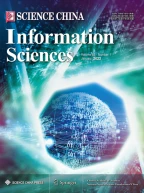Abstract
Software coordination is central to the construction of large-scale high-performance distributed applications with software services scattered over the decentralized Internet. In this paper, a new mobile-agent-based architecture is proposed for the utilization and coordination of geographically distributed computing resources. Under this architecture, a user application is built with a set of software agents that can travel across the network autonomously. These agents utilize the distributed resources and coordinate with each other to complete their task. This approach’s advantages include the natural expression and flexible deployment of the coordination logic, the dynamic adaptation to the network environment and the potential of better application performance. This coordination architecture, together with an object-oriented hierarchical parallel application framework and a graphical application construction tool, is implemented in the HOOPE environment, which provides a systematic support for the development and execution of Internet-based distributed and parallel applications in the petroleum exploration industry.
Similar content being viewed by others
References
Fayad, M. E., Schmidt, D. C., Object-oriented application frameworks, Communications of the ACM, 1997, 40: 32–38.
Schmidt, D. C., Fayad, M. E., Lessons learned, building reusable OO frameworks for distributed software, Communications of the ACM, 1997, 40: 85–87.
Birrer, A., Eggenschwiler, T., Frameworks in the financial engineering domain: An experience report, in Proceedings ECOOP’93 (Kaiserslautern, Germany, July 26–30) (ed. Nierstrasz, O.), LNCS 707, Berlin: Springer-Verlag, 1993, 21–35.
Bäumer, D., Gryczan, G., Knoll, R. et al., Framework development for large systems, Communications of the ACM, 1997, 40(10): 52–59.
Reynders, J., Hinker, P., Cummings, J. et al., POOMA: A framework for scientific simulations on parallel architectures, in Parallel Programming Using C + + (eds. Wilson, G. V., Lu, P.), Cambridge: MIT Press, 1996, 553–594. http://www.acl.lanl.gov/pooma/
Lu, J., Li, Y., Ma, X. et al., A hierarchical framework for parallel seismic applications, Communications of the ACM, 2000, 43(10): 55–59.
Foster, I., Kesselman, C. (eds.), The Grid: Blueprint for a New Computing Infrastructure, San Francisco, California: Morgan Kaufmann Publishers, Inc., 1999.
Arnold, D. C., Dongarra, J., The NetSolve environment: Progressing towards the seamless grid, in Proceedings of the 2000 International Workshop on Parallel Processing (ed. Sadayappan, P.), Los Alamitos: IEEE Computer Society, August 2000, 199–206.
Parker, S., Weinstein, D., Johnson, D., The SCIRun computational steering software system, in Modern Software Tool in Scientific Computing (eds. Arge, E., Bruaset, A., Langtangen, H.), Boston: Birkhauser Press, 1997, 1–44.
Grimshaw, A., Ferrari, A., Knabe, F. et al., Legion: An operating system for wide-area computing, IEEE Computer, 1999, 32(5): 29–37.
Steen, M., Homburg, P., Tanenbaum, A. S., Globe: A wide-area distributed system, IEEE Concurrency, January–March 1999, 70–78.
White, J., Telescript technology: Mobile agents, in Software Agents (ed. Bradshaw, J.), Menlo Park: MIT Press, 1996.
Lange, D. B., Oshima, M., Seven good reasons for mobile agents, Communications of the ACM, 1999, 42(3): 88–89.
Kotz, D., Gray, R. S., Mobile agents and the future of the internet, ACM Operating Systems Review, August 1999, 7–13.
Lange, D. B., Oshima, M., Mitsuru, O., Programming and deploying mobile agents with Aglets, New York: Addison-Wesley, 1998.
Gray, R., Agent Tcl: A flexible and secure mobile-agent system, Ph. D. Thesis, Dept. of Computer Science, Hanover: Dartmouth College, June, 1997.
Wong, D., Paciorek, N., Walsh, T. et al., Concordia: An infrastructure for collaborating mobile agents, in Mobile Agents, Proceedings of the First International Workshop, MA’97 (eds. Rothermel, K., Popescu-Zeletin, R.), LNCS 1219, April 1997, Berlin: Springer Verlag, 86–98.
Glass, G., Voyager: The new face of distributed computing, Object Magazine, Jun. 1997.
Lange, D. B., Mobile objects and mobile agents: The future of distributed computing? in ECOOP’98 Conference Proceedings, Berlin: Springer-Verlag, 1998, LNCS 1445, 1–13.
Lu, J., Tao, X., Ma, X. et al., The design of a mobile agent system Mogent, Technical Report of State Key Lab. for Novel Software Technology, Nanjing University.
Li, Y., The research and implementation of object-oriented parallel application framework. Ph. D. Dissertation, Nanjing: Nanjing University, October 1999.
Gannon, D., Bramley, R., Stuckey T. et al., Developing component architectures for distributed scientific problem solving, IEEE Computational Science & Engineering, April–June 1998, 50–63.
Fuggetta, A., Picco, P. G., Vigna, G., Understanding code mobility, IEEE Transactions on Software Engineering, 1998, 24(5): 342–361.
Finin, T., Labrou, Y., Mayfield, J., KQML as an agent communication language, in Software Agents (ed. Bradshaw, J.), Cambridge: MIT Press, 1997.
Medvinsky, G., Neuman, C., NetCash: A design for practical electronic currency on the internet, in Proceedings of the First ACM Conference on Computer and Communications Security, Fairfax VA, Nov. 1993, New York: ACM Press, 1993, 102–106.
Dyer, D. E., Multiagent systems and DARPA, Communications of the ACM, 1999, 42(3): 48–54.
Drashansky, T. et al, Networked agents for scientific computing, Communications of the ACM, 1999, 42(3): 48–54.
Xu, C., Wims, B., Mobile agent based push methodology for global parallel computing, Concurrency: Practice and Experience, 2000, 14(8): 705–726.
Izatt, M., Chan, P., Brecht, T., Ajents: towards an environment for parallel, distributed and mobile Java applications, Concurrency: Practice and Experience, 2000, 12(8): 667–685.
Mei, H., Chang, J., Yang, F., Software component composition based on ADL and Middleware, Science in China, Ser. F, 2001, 44(2): 136–151.
Cabri, C., Leonardi, L., Zambonelli, F., Mobile-agent coordination models for internet applications, IEEE Computer, 2000, 38(2): 82–89.
Author information
Authors and Affiliations
Corresponding author
Rights and permissions
About this article
Cite this article
Ma, X., Lü, J., Tao, X. et al. A mobile-agent-based approach to software coordination in the HOOPE system. Sci China Ser F 45, 203–219 (2002). https://doi.org/10.1360/02yf9019
Received:
Issue Date:
DOI: https://doi.org/10.1360/02yf9019
